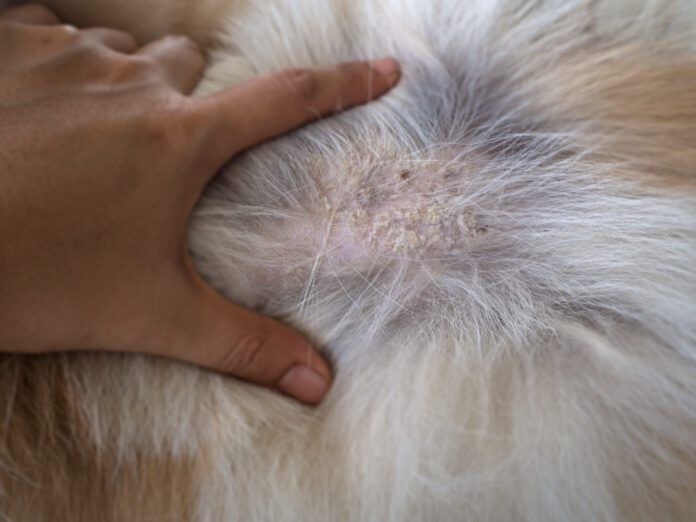Got flaky skin? Maybe with a little odor and grease? Your dog may have seborrhea.
Seborrhea is not a disease, but a description of an abnormal process occurring with your dog’s skin and sebaceous glands. It is a symptom of a broader spectrum of diseases called keratinization disorders.
Keratinization is the formation of the outermost layer of skin. A dog who has a disease that disrupts keratinization may have dry, flaky skin (known as seborrhea sicca) or they may have greasy, flaky skin that has an odor (known as seborrhea oleosa).
Keratinization disorders are divided into two categories: primary disorders and secondary disorders. Primary keratinization disorders include those that have a genetic (also known as inherited) cause. Secondary keratinization disorders always have an underlying primary cause, such as parasites, infections, endocrine diseases, allergies, auto-immune diseases, nutritional deficiencies or cancer.
Primary Keratinization Disorders in Dogs
Most primary keratinization disorders have a genetic cause. Those disorders for which a cause cannot be found are labeled idiopathic.
Genetic or hereditary causes include color dilution alopecia, follicular dysplasia, ichthyosis, and several other recognized conditions that affect certain breeds of dogs. These conditions are inherited and begin to manifest in puppies and young adults.
Color dilution alopecia affects dogs with a blue- or fawn-colored hair coat. Dogs with color dilution alopecia will experience thinning hair or patchy hair loss starting at about six months of age. Their skin may be flaky or even itchy. There is no cure for color dilution alopecia. This condition affects only a dog’s skin and not their overall health.
Follicular dysplasia is a group of genetic disorders that affect the structure of the hair shaft (individual hairs) and the hair follicle (the pore in which the root of the hair sits). Dogs with follicular dysplasia may have regional hair loss, a patchy change in coat color, or a coat with an uneven appearance. They may also have dry, flaky skin that is not itchy.
As with color dilution alopecia, there is no cure for follicular dysplasia. Treatment with retinoids may improve the overall condition of the skin and promote initial regrowth of fur. Even with treatment, hair loss will progressively worsen and become permanent.
Ichthyosis is a group of genetic disorders that affect the structure of the outermost layer of skin. The word prefix “ichthy” comes from the Greek word root for fish. Dogs with ichthyosis have skin that resembles the appearance of fish scales.
Dogs with color dilution alopecia, follicular dysplasia, or ichthyosis may benefit from periodic bathing with a medicated shampoo to manage their dry skin and any superficial skin infections that arise. Their skin should be protected from sun exposure, either with a sunscreen made for dogs or with clothing that blocks UV rays. Dogs with these conditions should not be bred, as they will pass the gene for their condition to their offspring.
Vitamin A dermatosis is an inherited condition that is rarely seen in dogs. Cocker Spaniels are the most affected breed, although this condition has been seen in other breeds of dogs. Some dogs with vitamin A dermatosis have skin that lacks a sufficient amount of vitamin A. Other dogs with this condition are not able to completely utilize the vitamin A in their skin. Vitamin A dermatosis may be treated with oral vitamin A supplementation and a class of medication called retinoids.
Zinc responsive dermatosis may have a genetic or nutritional cause. Type I zinc responsive dermatosis is an inherited condition that affects Siberian Huskies and Alaskan Malamutes. This condition can also be seen in Doberman Pinschers and Great Danes. Dogs with this condition have a genetic defect that limits the amount of zinc they can absorb from their small intestine. These dogs require lifelong supplementation of zinc.
The other two types of zinc responsive dermatosis have nutritional causes and are not inherited. These two types are discussed in the next section on secondary causes.
Secondary Keratinization Disorders in Dogs
Secondary keratinization disorders always have an underlying primary cause. Underlying primary causes include parasites, infections, endocrine diseases, allergies, auto-immune diseases, nutritional deficiencies, and cancer.
Parasitic causes of secondary keratinization disorders include demodicosis, sarcoptic mange, cheyletiellosis, and lice infestations. See the article “Treatment and Signs of Parasites in Dogs” for more information about these skin parasites and how to treat them.
Skin infections caused by bacteria, the yeast Malassezia, or dermatophytes (commonly known as ringworm) may result in a secondary keratinization disorder. Skin infections caused by bacteria or Malassezia are known as pyoderma. Dermatophyte infections are known as dermatophytosis. These infections are often treated with a combination of oral and topical medications.
Endocrine diseases that are associated with secondary keratinization disorders include hypothyroidism and hyperadrenocorticism (also known as Cushing’s disease). Your veterinarian may order blood and urine tests if she suspects one of these endocrine diseases. Both diseases are treated with daily oral medication.
The broad category of allergies includes any cause of atopic dermatitis (also known as atopy), flea allergy dermatitis, food hypersensitivities, and allergies to contact or airborne allergens. See the article “Allergies in Dogs” for more information on diagnosis of allergies and treatment.
Secondary keratinization disorders may be caused by immune-mediated diseases (also known as auto-immune disorders), such as pemphigus foliaceus, systemic lupus erythematosus (SLE), sebaceous adenitis, and cutaneous drug reactions. In auto-immune disorders, the dog’s immune system forms antibodies against some of its own cells or tissues. This causes damage to the affected cells or tissues in the body. Auto-immune disorders are treated with medications that regulate the body’s immune system.
The types of zinc responsive dermatosis that have a nutritional cause are known as type II and type III zinc responsive dermatosis. Type II zinc responsive dermatosis is caused by eating a diet that is high in calcium or phytates. Phytates (also known as phytic acid) are found in seeds, nuts, legumes, and grains. Phytates interfere with the absorption of zinc, calcium, and iron. Your veterinarian will recommend diets appropriate for your dog if he has type II zinc responsive dermatosis.
Type III zinc responsive dermatosis is caused by feeding a diet that contains insufficient levels of zinc. This may include home-cooked diets that are not correctly supplemented with appropriate levels of vitamins and minerals. Diets that do not contain the recommended minimum amount of zinc may also cause this type of dermatosis.
Cutaneous lymphoma is a form of cancer that affects the lymphocytes in a dog’s skin. Dogs with cutaneous lymphoma may have red, scaly and flaky skin. Other manifestations of this illness include having one or more raised and ulcerated lesions of the skin, nose, or lips; thickened and ulcerated gums in the mouth; or loss of pigment at the end of the nose.
Diagnosing Canine Keratinization Disorders
Secondary keratinization disorders are more common than primary keratinization disorders in dogs. Your veterinarian will start with diagnostic tests that include a skin swab cytology, a skin scrape cytology, and a fungal culture. Other tests may include blood work, including a complete blood count and chemistry panel. A biopsy of affected skin with histopathology performed by a veterinary dermatology pathologist may be necessary to determine the underlying cause.
With proper diagnosis and treatment, your dog can achieve relief from the discomfort of seborrhea. Talk to your veterinarian about an appropriate diagnostic and treatment plan for your dog’s condition.






